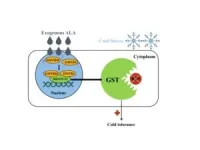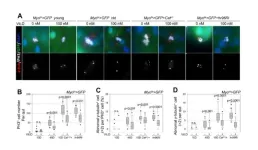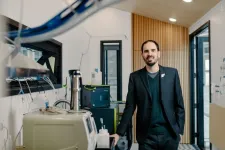(Press-News.org) People who are diagnosed with head and neck cancer often receive a standard type of chemotherapy as part of their treatment. If they are exposed to secondhand smoke during chemotherapy — even if they have never smoked themselves — the treatment may be far less effective at killing cancer cells. That finding, considered the first of its kind, was revealed in a study recently published by researchers at the University of Oklahoma Health Sciences.
Tobacco use is a well-established risk factor for cancer and a signal of poor outcomes, especially if a person continues to smoke during treatment. However, researchers have understood much less about the effects of secondhand smoke on cancer treatment. Lurdes Queimado, M.D., Ph.D., a professor of otolaryngology at the OU College of Medicine, led the investigation into secondhand smoke exposure, which was published in the International Journal of Molecular Sciences. Her findings have major implications for cancer patients and the physicians who treat them.
“Head and neck cancer is the sixth most common cancer worldwide and is prevalent in Oklahoma, where we also have a high rate of smoking. This is the first time that researchers have examined the impact of secondhand smoke exposure on cancer patients and the mechanism of why it is happening. Our studies will continue, but we think it is important to raise awareness now that people who are exposed to secondhand smoke during treatment will likely have a worse prognosis,” said Queimado, who also directs the Tobacco Regulatory Science Lab in the TSET Health Promotion Research Center, a program of OU Health Stephenson Cancer Center.
In her laboratory, Queimado and her team exposed head and neck cancer cells to secondhand smoke for 48 hours (a control group of cancer cells was not exposed to secondhand smoke). Simultaneously, the cells were treated with cisplatin, a chemotherapy drug commonly used to treat head and neck cancer. The findings were significant: Twice as much chemotherapy was needed to kill the cells than would have been necessary without exposure to secondhand smoke. In addition, the cancer cells that survived chemotherapy treatment were much more likely to replicate indefinitely.
“This was concerning to discover because not only was the effectiveness of the chemotherapy cut in half, but the cells that survived were able to divide and create huge colonies of cancer cells,” Queimado said. “If the chemotherapy can’t kill all the cancer, it will come back. And it will come back sooner because the cells are dividing so quickly. In addition, we cannot simply double the amount of chemotherapy we give to patients because it would be too toxic.”
Queimado and her team took the research a step further to understand how secondhand smoke decreases the effectiveness of chemotherapy. They found that secondhand smoke alters the expression of several proteins involved in drug resistance, effectively restricting chemotherapy’s ability to do its job.
“Cisplatin kills cancer cells by binding to their DNA and keeping the cells from dividing,” she said. “But if cisplatin can’t get into the cell, it’s not going to kill it. Essentially, there are doors to the cancer cells that control how cisplatin gets in and out. In the presence of secondhand smoke, there were fewer doors for cisplatin to enter, and there were many more doors for cisplatin to exit. So not only is less cisplatin getting into the cell, but more of it is leaving the cell before it has a chance to kill it.”
Greg Krempl, M.D., professor and chair of the Department of Otolaryngology – Head and Neck Surgery in the OU College of Medicine, said Queimado’s study broadens the importance smoking cessation during cancer treatment.
“For patients with tobacco-related cancers, smoking cessation has been shown to improve survival, so it is a part of comprehensive cancer treatment plans. This study provides novel data that would suggest including family members in the smoking cessation plan to reduce secondhand smoke exposure during chemotherapy for head and neck cancer may improve outcomes,” Krempl said.
According to tobacco use data, more than 20% of nonsmoking U.S. adults are exposed to secondhand smoke. Exposure is highest among Black people, those living in poverty, and children ages 3 to 11. Each year, secondhand smoke exposure causes more than 41,000 deaths among nonsmoking adults and 900 deaths in infants.
This new study points to the ongoing public health ramifications of both active smoking and exposure to secondhand smoke, said Balaji Sadhasivam, Ph.D., an assistant professor of occupational and environmental health at the OU Hudson College of Public Health. Sadhasivam was the lead author of the research publication.
“Even though this study was conducted in the laboratory, it closely mimics human exposure to secondhand smoke,” Sadhasivam said. “If cancer patients live with someone who smokes, it is important for them to avoid being exposed to smoke while they are being treated. We want to do everything we can to help people have better outcomes from their treatment.”
Cisplatin is the preferred type of chemotherapy for treating head and neck cancer, Queimado said, but physicians may want to consider another drug if they know their patients will be exposed to secondhand smoke during treatment. However, secondhand smoke exposure may affect other drugs, including non-cancer treatments.
“The proteins affected by secondhand smoke are not specific for cisplatin; they are involved in resistance to other drugs. We have not studied that yet, but it is likely that secondhand smoke decreases the effectiveness of several types of drugs.”
END
Exposure to secondhand smoke during chemotherapy makes treatment less effective, study shows
Research considered first to examine role of secondhand smoke
2024-02-27
ELSE PRESS RELEASES FROM THIS DATE:
Polar climates changing in fundamental ways
2024-02-27
[Boston, MA—February 27, 2024] Research recently published early online in journals of the American Meteorological Society demonstrates changes at the Earth’s poles, including altered ocean-sea ice dynamics, dampened temperature extremes, and differing responses to solar radiation at the north and south poles, and suggests that long-term warming trends may have played more of a role in 2023’s record-low Southern Ocean ice than previously supposed.
Three papers in the Journal of Climate (JCli) find that the Arctic and Antarctic appear to be adjusting to a warming climate with fundamental changes in regional climate dynamics.
The Antarctic ocean-sea ice system may be fundamentally ...
Remote online genetic education programs can spur testing for inherited susceptibility to cancer, study suggests
2024-02-27
Even as it's become clear that an inherited susceptibility to some cancers is more common than once thought, genetic testing of family members of cancer patients hasn't increased as much as experts had hoped. A new study led by researchers at Dana-Farber Cancer Institute and Brigham and Women’s Hospital demonstrates that a remote online genetic education program can be a powerful motivator for people with a family history of cancer to undertake genetic testing.
The GENetic Education, Risk Assessment, and TEsting (GENERATE) study included 601 people from across 45 states who had a close relative with the most common form of pancreatic cancer. Participants ...
Study shows daylight saving time has minimal effect on heart health
2024-02-27
ROCHESTER, Minn. — A recent Mayo Clinic study examining the effects of daylight saving time (DST) on heart health suggests that the impact is likely minimal.
In the nationwide study, researchers applied an advanced statistical model to look for any connections between DST and serious cardiovascular problems, including heart attacks and strokes. The study looked at 36,116,951 adults aged 18 and up across most U.S. states. (Arizona and Hawaii were excluded since these states do not observe DST.)
Researchers focused on the week directly after the spring and fall DST transition, ...
New disease testing component facilitates lower-cost diagnostics
2024-02-27
A new tool could reduce costs for diagnosing infectious diseases.
Biomedical researchers from The University of Texas at Austin have developed a new, less expensive way to detect nuclease digestion – one of the critical steps in many nucleic acid sensing applications, such as those used to identify COVID-19 and other infectious diseases.
A new study published in the journal Nature Nanotechnology shows that this low-cost tool, called Subak, is effective at telling when nucleic acid cleavage occurs, which happens when an enzyme called nuclease breaks down nucleic acids, such as DNA or RNA, into smaller fragments.
The traditional way of identifying nuclease ...
White House includes two Tufts-related initiatives in commitments to end hunger, reduce diet-related disease
2024-02-27
Two Tufts-related initiatives have been included in the White House’s new round of public and private sector commitments, announced today by the Biden-Harris administration, to end hunger, improve nutrition, and reduce diet-related disease in the United States by 2030. The White House Challenge to End Hunger and Build Healthy Communities continues the Biden-Harris administration’s work started at the historic White House Conference on Hunger, Nutrition, and Health that was held in September 2022, encouraging stakeholders from all corners to develop bold commitments to help achieve the administration’s five key pillars of national ...
U of M-led research identifies predictor of outcomes, chemoresistance for ovarian cancer patients
2024-02-27
MINNEAPOLIS/ST. PAUL (2/27/2024) — In a major scientific breakthrough, newly published research from an international consortium led by the University of Minnesota’s Masonic Cancer Center has the potential to transform the landscape of ovarian cancer treatment.
Published today in JAMA Network Open, the findings indicate that ovarian cancer patients with high levels of stroma within their tumors are twice as likely to exhibit chemoresistance to the conventional standard of care. Stroma is the non-cancerous tissue that provides support to tumors.
The ...
NRG Oncology announces new leadership of Canadian Members Subcommittee
2024-02-27
NRG Oncology, a National Cancer Institute (NCI) National Clinical Trials Network (NCTN) group focused on improving outcomes for adults with cancer through multi-center clinical research, recently announced a new Chair and Vice Chair of the organization’s Canadian Members Subcommittee.
The NRG Canadian Members Subcommittee is tasked with engaging and supporting NRG’s Canadian member institutions through their participation in NRG research. This subcommittee was created to tackle the unique regulatory, administrative, and ...
Bariatric surgery provides long-term blood glucose control, type 2 diabetes remission
2024-02-27
BATON ROUGE – People with type 2 diabetes who underwent bariatric surgery achieved much better long-term blood glucose control compared to people who received medical management plus lifestyle interventions, according to a new study published in JAMA, or Journal of the American Medical Association, and funded by the National institute of Diabetes, Digestive and Kidney Diseases, part of The National Institutes of Health.
In addition, participants who underwent bariatric surgery, also called metabolic or weight-loss surgery, were more likely to stop needing diabetes medications and had higher rates of diabetes remission up to 12 years post-surgery. ...
The anti-aging effect of vitamin D and vitamin D receptor in Drosophila midgut
2024-02-27
“Our study demonstrated that the VitD/VDR [vitamin D/vitamin D receptor] pathway is required for intestinal homeostasis during normal differentiation and aging.”
BUFFALO, NY- February 27, 2024 – A new research paper was published in Aging (listed by MEDLINE/PubMed as "Aging (Albany NY)" and "Aging-US" by Web of Science) Volume 16, Issue 3, entitled, “The anti-aging effect of vitamin D and vitamin D receptor in Drosophila midgut.”
Adult stem cells are pivotal for maintaining tissue homeostasis, and their functional ...
You may be breathing in more tiny nanoparticles from your gas stove than from car exhaust
2024-02-27
WEST LAFAYETTE, Ind. — Cooking on your gas stove can emit more nano-sized particles into the air than vehicles that run on gas or diesel, possibly increasing your risk of developing asthma or other respiratory illnesses, a new Purdue University study has found.
“Combustion remains a source of air pollution across the world, both indoors and outdoors. We found that cooking on your gas stove produces large amounts of small nanoparticles that get into your respiratory system and deposit efficiently,” said Brandon Boor, an associate professor in Purdue’s Lyles School of Civil Engineering, who led this research.
Based on these ...
LAST 30 PRESS RELEASES:
Global psychiatry mourns Professor Dan Stein, visionary who transformed mental health science across Africa and beyond
KIST develops eco-friendly palladium recovery technology to safeguard resource security
Statins significantly reduce mortality risk for adults with diabetes, regardless of cardiovascular risk
Brain immune cells may drive more damage in females than males with Alzheimer’s
Evidence-based recommendations empower clinicians to manage epilepsy in pregnancy
Fungus turns bark beetles’ defenses against them
There are new antivirals being tested for herpesviruses. Scientists now know how they work
CDI scientist, colleagues author review of global burden of fungus Candida auris
How does stroke influence speech comprehension?
B cells transiently unlock their plasticity, risking lymphoma development
Advanced AI dodel predicts spoken language outcomes in deaf children after cochlear implants
Multimodal imaging-based cerebral blood flow prediction model development in simulated microgravity
Accelerated streaming subgraph matching framework is faster, more robust, and scalable
Gestational diabetes rose every year in the US since 2016
OHSU researchers find breast cancer drug boosts leukemia treatment
Fear and medical misinformation regarding risk of progression or recurrence among patients with breast cancer
Glucagonlike peptide-1 receptor agonists and asthma risk in adolescents with obesity
Reviving dormant immunity: Millimeter waves reprogram the immunosuppressive microenvironment to potentiate immunotherapy without obvious side effects
Safety decision-making for autonomous vehicles integrating passenger physiological states by fNIRS
Fires could emit more air pollution than previously estimated
A new way to map how cells choose their fate
Numbers in our sights affect how we perceive space
SIMJ announces global collaborative book project in commemoration of its 75th anniversary
Air pollution exposure and birth weight
Obstructive sleep apnea risk and mental health conditions among older adults
How talking slows eye movements behind the wheel
The Ceramic Society of Japan’s Oxoate Ceramics Research Association launches new international book project
Heart-brain connection: international study reveals the role of the vagus nerve in keeping the heart young
Researchers identify Rb1 as a predictive biomarker for a new therapeutic strategy in some breast cancers
Survey reveals ethical gaps slowing AI adoption in pediatric surgery
[Press-News.org] Exposure to secondhand smoke during chemotherapy makes treatment less effective, study showsResearch considered first to examine role of secondhand smoke





